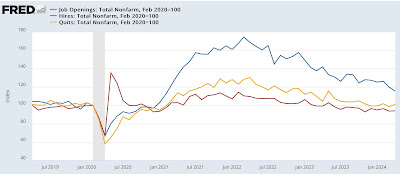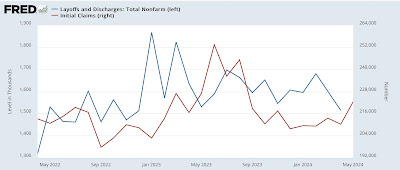– by New Deal democrat The JOLTS report for April showed most metrics rebounding slightly from March lows, with the exception of the “soft data” job openings. The overall picture is that hiring is weak relative to the past five years, but so are layoffs, and voluntary quits are equally relatively strong, balancing them out. To wit: job openings (blue in the graph below), a soft statistic that is polluted by imaginary, permanent, and trolling listings, declined -another 296,000, form a downwardly revised March, to yet another three year low of 8.059 million (vs. a pre-pandemic peak of 7.594 million). Actual hires (red) rose 23,000 from an upwardly revised March to 5.640 million (vs. a pre-pandemic peak of 6.0 million). Voluntary quits (gold)
Topics:
NewDealdemocrat considers the following as important: April 2024, Hot Topics, Jolts Report, US EConomics
This could be interesting, too:
NewDealdemocrat writes JOLTS revisions from Yesterday’s Report
Joel Eissenberg writes No Invading Allies Act
Bill Haskell writes The North American Automobile Industry Waits for Trump and the Gov. to Act
Bill Haskell writes Families Struggle Paying for Child Care While Working
– by New Deal democrat
The JOLTS report for April showed most metrics rebounding slightly from March lows, with the exception of the “soft data” job openings. The overall picture is that hiring is weak relative to the past five years, but so are layoffs, and voluntary quits are equally relatively strong, balancing them out.
To wit: job openings (blue in the graph below), a soft statistic that is polluted by imaginary, permanent, and trolling listings, declined -another 296,000, form a downwardly revised March, to yet another three year low of 8.059 million (vs. a pre-pandemic peak of 7.594 million). Actual hires (red) rose 23,000 from an upwardly revised March to 5.640 million (vs. a pre-pandemic peak of 6.0 million). Voluntary quits (gold) rose 98,000 from an upwardly revised March to 3.507 million. In the below graph, they are all normed to a level of 100 as of just before the pandemic:
As has been the case for the past nine months, hires are below the level they were at just in early 2020 just before the pandemic hit. Meanwhile, quits are essentially equal to their pre-pandemic level.
The above situation has been considerably helped by layoffs and discharges (blue in the graph below), which made a sixteen-month low, and continue to run roughly 20% below the level they had been at *any* point before the pandemic:
As with last month, the more leading weekly initial jobless claims (red) suggest that layoffs and discharges will remain close to this range at least for several more months.
Finally, the quits rate was unchanged at 2.2% for the sixth month in a row, after an upward revision from March. Since, as I have noted for a number of months now, the quits rate (blue in the graph below, right scale) tends to lead average hourly earnings (red) [and here’s the long-term view]:
This suggests that the deceleration in wage growth will probably not decelerate much further in upcoming months, as shown in the below post-pandemic close-up:
My big concern over the past year has been if a further deceleration in wage growth were to coincide with an upturn in inflation, because that would likely cause a decline in real consumer income and spending. While there is no reason in today’s numbers to discount the longer term post-pandemic trend of deceleration, there was no further deceleration in April.
March JOLTS report: declines in everything, fortunately including layoffs, Angry Bear, by New Deal democrat




